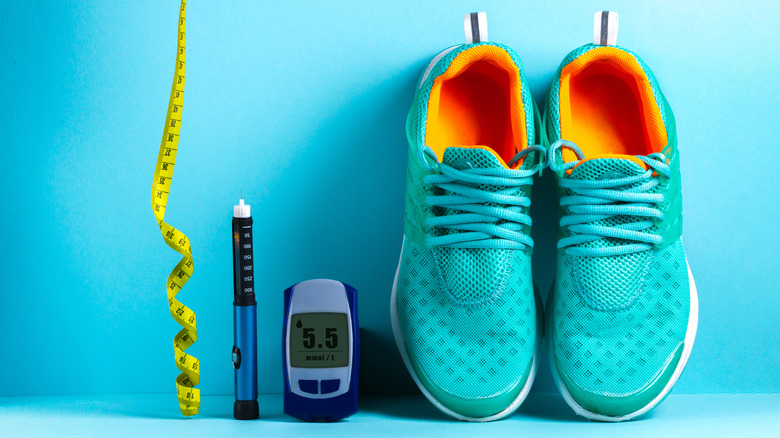What Happens To Your Body When You Take A Walk Every Day
Walking may not be as celebrated as more intense forms of exercise. Nevertheless, the fact of the matter is that walking is a physical activity that gets your body moving, your muscles working together, and your heart pumping. And, despite its low intensity, walking is actually one of the best things you can do for your body; science says so! Because it's low impact, walking may allow people who experience hip, leg, back, or joint pain to participate with guidance from their doctor.
Healthline notes the calorie burn anyone can get from walking based on their weight and speed: A 180-pound person on a leisurely walk of 2.0 miles per hour can shed 204 calories in an hour, and bumping up the pace to a brisker walk of 3.5 mph burns 311 calories. Add a walk to your morning routine, and you could even get a metabolism boost throughout the day (per Time).
The moral of the story? Get a walk in daily, if possible. When you do, you'll notice some incredible, positive changes happening to your body.
Your bones get denser
Low bone density may be a sign of osteoporosis, which exists when bones lose mass, becoming weak and brittle. According to the International Osteoporosis Foundation, 10.2 million people 50 years of age and older in the United States have osteoporosis, and the overwhelming majority of them are women.
However, daily walking could actually prevent osteoporosis. WebMD explains that aerobic exercise may contribute to healthier bones. As an aerobic exercise, walking fits the bill. When you walk, you support your body weight with your legs, which could, in turn, prevent bone loss by strengthening your bones. Of course, it's also important to target your other bones too, which is why combining strength training with a walking routine is beneficial.
But if you can only fit in walking, stick to that. Research from an older study in The American Journal of Medicine found higher bone density in healthy postmenopausal women who walked just one mile a day compared to women who walked less than that amount.
Your heart gets healthier
There are a lot of factors that contribute to your overall heart health, like blood pressure, inflammation, and muscle strength. Interestingly, walking each day can potentially target most of them, leading to a healthy, happy heart.
According to Johns Hopkins Medicine, aerobics, like walking, combined with a strength training routine can strengthen muscles. When your muscles get stronger, they become more efficient at moving oxygen through the blood, putting less strain on your heart. Exercises like walking can also slow your heart rate, reduce blood pressure, and decrease inflammation, all of which are heart-healthy processes.
Your walking speed might even indicate how healthy your heart is. Preventive cardiologist Haitham Ahmed explained to the Cleveland Clinic the results of a study published in the European Heart Journal, saying, "The study found that people who were brisk walkers had significantly lower cardiac and all-cause death, which makes sense, because those people have higher cardiorespiratory fitness." Dr. Ahmed also noted that people who believe their walking speed has been slowing down over time might be experiencing their heart signaling that there's a problem.
Your joints become less stiff
Muscle and joint stiffness are somewhat normal to experience when you've been inactive for long periods (via Medical News Today). When you get out of bed in the morning or stand up from your desk when it's break time, it's not uncommon to feel stiffness in your back, hips, and legs because they haven't been moved around in a while. Naturally, moving around more or taking quick breaks at work to squeeze in a few stretches can keep your muscles and joints loosened up. With a regular exercise routine, you could feel more limber overall.
Daily walks can also combat stiffness, even for people who live with arthritis. As Creaky Joints, a research organization for people with arthritis and rheumatic disease, explains, walking can strengthen muscles to protect your joints and send more blood flow to your joint cartilage to keep it strong and healthy. The additional benefit of potentially losing weight when you walk regularly is the icing on the cake for people with arthritis, as those extra pounds can flare inflammation that causes joint pain.
Your eyesight might improve
It's truly fascinating to think about walking being a helpful activity for your eyesight, but according to the Glaucoma Research Foundation (GRF), that's exactly what it is. Regularly participating in moderate exercise like daily brisk walking can reduce intraocular pressure (IOP). GRF notes that increased IOP is a notable symptom of glaucoma, an eye condition that causes damage to the optic nerve and may lead to blindness.
Even if you don't have glaucoma or other severe optical conditions, walking might still help you keep your vision in check and prevent vision issues down the road. A 2020 article from the American Academy of Ophthalmology explains the results of a study focused on the relationship between exercise and eyesight, specifically macular degeneration, which can cause vision loss. The study separated mice into two groups, one with access to an exercise wheel for four weeks and the other without. After researchers treated all mice eyes with lasers to simulate age-related vision loss, the mice group that exercised has as much as 45% less vision damage.
Your brain gets a boost
You might notice that when you take a walk, you get a feel-good attitude rush over you. There's actually something scientific happening when you feel this sense of positivity from a walk. According to WebMD, walking offers a natural pick-me-up when blood flow and circulation increase. The process calms your central nervous system, and when your nerves are calm, you feel more at ease. Plus, we know that spending too much time inside can make you feel fatigued, anxious, and depressed, so getting outside for a walk might just increase the fantastic benefits of walking.
Walking can also improve your brain's function in general. Teresa Liu-Ambrose, one author of a study published in the British Journal of Sports Medicine, told Reuters, "[Regular aerobic exercise] reduces one's risk of developing chronic conditions such as high blood pressure, diabetes (type II), and high cholesterol. These chronic conditions harm the brain — likely through compromised blood flow to the brain." The brain needs excellent blood flow regularly to keep it healthy, and a consistent walking routine can do the trick.
Your metabolism improves
Metabolism affects the way your body breaks down food for energy. The better your metabolism, the more calories you can burn at rest, leading to more efficient calorie and fat burn. Exercise, in general, is known to boost your metabolism when you participate in it regularly, but is walking every day enough?
According to Livestrong, yes, walking can have a positive impact on your metabolism. Even walking at a leisurely pace can give you a slight metabolism boost, but how much you increase your metabolism usually depends on the intensity of your walk. For instance, walking mostly uphill can increase fat burn more than an even-level walk, and walking faster with more effort can also shed more calories and fat. And, walking regularly throughout the week can bump up your basal metabolic rate (BMR), allowing you to burn more calories even when you're not walking or exercising.
The key to getting the most out of your walks is to give them your best effort. Go a little faster, pump your arms, or try a new route with some extra hills to give your metabolism a jumpstart.
You could shed some pounds
Walking obviously burns calories (most everything you do does!). And when you burn more calories than you consume, you lose weight. A regular walking routine combined with a healthy, calorie-conscious diet could lead to a lower number on the scale.
Verywell Fit explains that you can lose between 200 to 600 calories per hour when walking, depending on your weight and intensity level. If you walk every day, that's as much as 4,200 calories burned each week, which is more than the 3,500 calories needed to lose one pound (via U.S. Department of Agriculture). Of course, you'll need to make sure you're not overeating your recommended number of calories each day to maintain that weight loss.
Want to make sure you're doing everything you can on your walks for maximum calorie burn? Eat This, Not That suggests walking to a playlist that keeps you energized and finding a motivating buddy to walk with to add variety and interest to your routine. For an extra burn, try varying your walking pace, accelerating and decelerating to get your metabolism working with you.
You'll have more energy
It can sometimes feel like a chore to get up and exercise. But once you get outside and complete a walk, you feel more energized than you did before you started, right? There's science behind this phenomenon. According to the Harvard T.H. Chan School of Public Health, cardiovascular activities like walking help "boost energy levels by releasing certain hormones like endorphins and delivering oxygen throughout the body." That's why getting into the swing of a regular walking routine might help you maintain energy throughout the day.
Research has also backed this up. WebMD detailed the results of a 2006 study that analyzed dozens of other studies on exercise and fatigue. Overwhelmingly, people in the studies who participated in regular exercise routines noted feeling less fatigue than people who led more sedentary lives. It just goes to show that leading a more active lifestyle might give you the energy you've been craving.
Your blood sugar levels even out
When you participate in physical activity, your blood sugar levels can decrease for 24 hours or even more (via the American Diabetes Association). That's one reason your doctor will tell you to get started with a regular exercise routine if you're consistently showing an elevated A1C reading or elevated blood glucose when you get bloodwork done. Along with a healthy diet, getting moving may decrease your blood sugar to prevent the onset of diabetes, especially in those with prediabetes (per WebMD).
And walking can be as good an exercise as any other to stave off the effects of high blood sugar. Research published in the American Diabetes Association's Diabetes Care publication studied inactive participants aged 60 or older who were at risk for glucose intolerance. After walking for 15 minutes after each of their three meals per day, participants experienced better glycemic control than without the walks. Interestingly, postmeal walking led to better glycemic control than 45-minute daily walks, suggesting that intermittent walking could be beneficial for those looking to control their blood sugar levels.
Your lungs become more efficient
When you exercise, your lungs become stronger, much like your muscles. As they expand and contract, they build strength, eventually making them more efficient at doing their job. During exercise, their job is to keep allowing you to breathe, of course, but also to help the heart move oxygen through the body and to the muscles that need them.
According to the American Lung Association, "As your physical fitness improves, your body becomes more efficient at getting oxygen into the bloodstream and transporting it to the working muscles. That's one of the reasons that you are less likely to become short of breath during exercise over time."
As an aerobic activity, walking makes the heart and lungs work a bit harder, which gives them the exercise they need to work together, function properly, and get oxygen over to the muscles to keep building strength and burning calories.
You'll sleep better at bedtime
Do you stay awake at night for hours, tossing and turning until you eventually drift off? Start a new walking regimen each day, and you might find that falling asleep is much easier.
A group of 490 people in a 2016 study participated in a four-week walking regimen of 10,000 steps daily. Researchers found that the walking program increased the participants' Pittsburgh Sleep Quality Index (PSQI) scores and sleep duration, decreased the length of time to fall asleep, and improved their perceived sleep quality.
How does it work? It has a lot to do with your circadian rhythm, which physical activity can help (via National Sleep Foundation). Exercise can energize you, which could make you feel more alert and awake during the day. Once bedtime arrives, you might feel more ready to turn in, making it less likely that you'll stay awake for a long period of time before falling asleep. Physical activity can also increase sleep quality and help you stay asleep longer to feel more refreshed in the morning.
Your body fights the urge to smoke
When you're a smoker, the overwhelming urge to smoke can make it difficult to quit. And, sometimes stopping smoking means swapping one bad habit with another to combat the urge (via Today). However, regular walking may be beneficial for smokers who want to quit smoking — and it's definitely not a bad habit to put in its place.
Exercise can have lasting effects on your mood, even when you're anxious or depressed. If your moods influence your smoking habits, a regular walking routine could stave off the cravings by lifting your mood. According to SmokeFree.gov, aerobic exercises — even in short periods — can fight the urge to smoke. While you're out walking, you might not even think about lighting another cigarette, and the effect can last up to 50 minutes after you stop walking. So, the more you walk, the easier it might be to take your mind off smoking and get to the healthy place you want to be in.
Your body could say no to certain conditions
When you're at risk for cancer, type 2 diabetes, or heart conditions, your doctor might gently encourage you to take up walking. That's because this simple movement may help prevent such conditions.
According to the American Cancer Society, studies have linked walking with a lowered risk of certain types of cancers, such as colon cancer and breast cancer. Notably, even walking less than the recommended guidelines still seemed to positively affect the mortality rates of participants, based on the results of a study led by the organization.
As for diabetes, Harvard Health Publishing notes that exercise increases your body's insulin sensitivity and lowers blood sugars naturally. Plus, exercises like walking can reduce HbA1c naturally, which is an important indicator that your body is better at handling blood sugar levels. The publication suggests exercising within one to three hours after eating for best results.
Finally, those with or without a risk for heart disease can benefit from walking 30 minutes or more each day. Walking comes with several heart-healthy benefits, like potential weight loss, maintaining blood pressure and blood cholesterol, and controlling diabetes. And those result in a lowered risk of heart disease and stroke (per the National Heart Foundation of Australia).
Your body might become more capable of other forms of exercise
Not only is walking in itself a great exercise, but it might also lead you to more challenging activities once you gain confidence and build strength and endurance. Yes, regular walking might be just the motivation you need to transition into exercises that can burn even more calories, like circuit training or running.
Olympic marathon runner Julie Isphording told WebMD that it all starts with walking. "Whenever you embark on a fitness program and you want to become a runner, you start by walking," Isphording explained. "Then you set a goal, like from this stop sign to the next corner, I'm going to run. You keep building that until you're jogging."
Even a little bit of jogging or running mixed in with your walking routine can boost its overall health benefits, including burning more calories and reducing muscle fatigue. If you're physically able, try starting with a light jog for a few seconds and switch back to walking. Then, keep increasing the amount of time you jog and your intensity until you can build up to a run.















